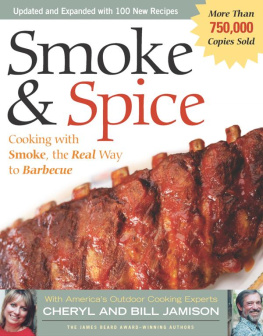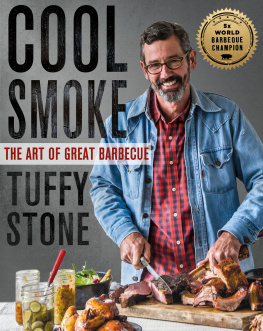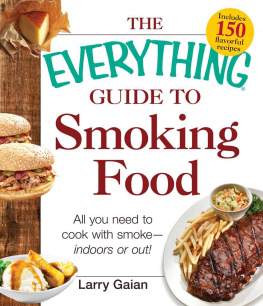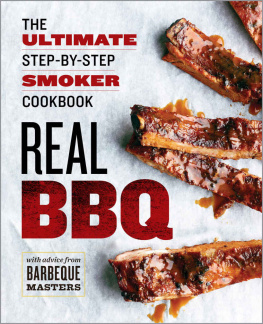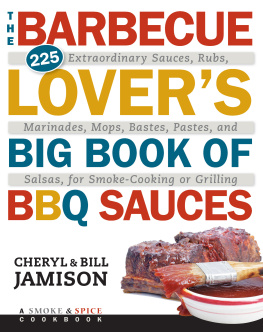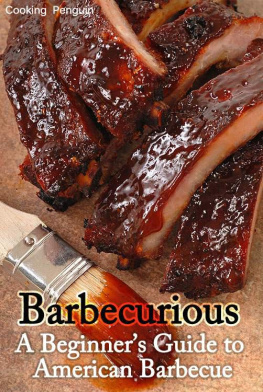The Harvard Common Press
www.harvardcommonpress.com
Copyright 2014 by Cheryl Alters Jamison and Bill Jamison
Photographs copyright 2014 by Gabriella Marks
All rights reserved. No part of this publication may be reproduced or transmitted in any form or by any means, electronic or mechanical, including photocopying, recording, or any information storage or retrieval system, without permission in writing from the publisher.
The Library of Congress has cataloged the print edition as follows:
Jamison, Cheryl Alters.
Smoke & spice : cooking with smoke, the real way to barbecue / Cheryl and Bill Jamison.
Third edition.
pages cm
Includes index.
ISBN 978-1-55832-836-5 (alk. paper)
1. Barbecuing. 2. Smoked foods. 3. Spices. I. Jamison, Bill. II. Title. III. Title: Smoke and spice.
TX840.B3.J36 2014
641.6'16dc23
2013036553
e ISBN 978-1-55832-837-2
v1.0414
Special bulk-order discounts are available on this and other Harvard Common Press books. Companies and organizations may purchase books for premiums or resale, or may arrange a custom edition, by contacting the Marketing Director at the web address above.
PHOTOGRAPHY BY Gabriella Marks; FOOD AND PROP STYLING BY Stacy Pearl; smoke wrangling by Mike Whistler
COVER DESIGN BY Night & Day Design
TEXT DESIGN & ILLUSTRATION BY Richard Oriolo
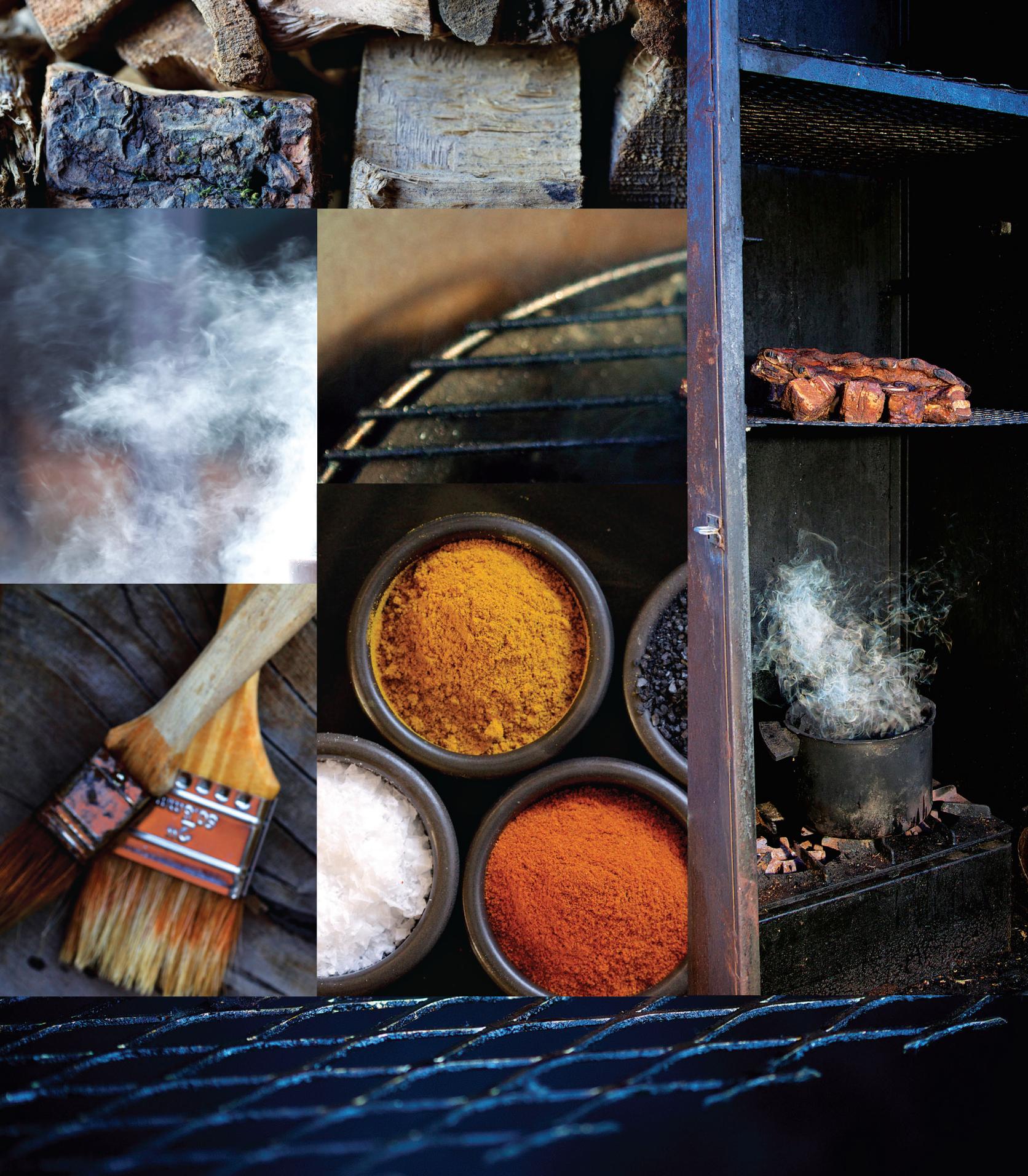
To that merry band of barbecue fanatics whove done so much over the past few decades to bring an old American craft back to its homegrown rootsespecially to Wayne and PJ Whitworth and the late Jim Quessenberry.
Preface to The New Revised Edition
FROM THE TIME WE FIRST started writing cookbooks, almost twenty-five years ago, weve focused our work on underappreciated foods and the cultures that surround them. Our dozen-plus cookbooks so far have dealt with topics like Texas and New Mexico home cooking, border traditions that Americans share with northern Mexico, and breakfast outside the boxsubjects that dont make much buzz when chefs and other culinary pros gather.
Imagine our shock, then, when the cookbook that seemed to us the most clearly out of the mainstream happened upon a trend. When we decided to write Smoke & Spice, even our long-term publisher initially balked at the idea. Who could possibly be interested in an old-fashioned style of cooking that takes more time than a turtle running a marathon and envelops you for the duration in a clinging cloud of smoke? We had trouble finding anyone except our meat-market bookkeeper who thought that real barbecue was cookbook material. We didnt care, though, because we love barbecue and knew that it would be great fun to cook, eat, and write about.
Smoke & Spice just happened to appear during a period when Americans wanted to spend more time outside, when we finally got fed up with burned birds for outdoor dinners, when we began to give credibility to genuine American cooking. These and lots of other reasons that we dont understand caused a revival of interest in real, smoke-cooked barbecue. The book came out in 1994 and lots of people bought it, probably at the insistence of wives who worried that Dad was going to burn down the neighborhood.
Two decades later, barbecue continues to soar in popularity. The kinds of barbecue joints that once thrived only in the barbecue belt of the South now pop up in all corners of the country, in almost every town with more than a single stoplight. The joints keep getting fancier, too, serving their meat and sides on real ceramic plates, which sometimes even sit on an actual tablecloth. Tending the pit outside may be a professional chef trained in the culinary arts, and one of the diners inside might be an accredited restaurant critic wowed by the wonders of smoked meat. Americans everywhere now seem to have accepted barbecue as our true red-white-and-blue national folk food.
This enormous shift in mood and attitude made it imperative for us to take a fresh look at our book, even though it had already been extensively revised once in 2003. We didnt want to tamper with the original recipes, but we wanted the pages to reflect the important changes that have occurred in the last decade in barbecue culture and cooking. So weve added new dishes, about fifty in all, recharged the practical information and tips, and updated our stories about the landscape of the barbecue craft.
We had almost as much fun revisiting Smoke & Spice as we did writing the original version twenty years ago. We hope you share some of that joy with us as you cook and eat from this new edition. If so, you may just be in hog heaven for years to come.
A Passion, A Pastime, and A Party
ITS TIME TO GRADUATE from grilling. American cooks have been enrolled in Introductory Barbecue for a half century now, since the days when we all liked Ike. Weve enjoyed cooking outdoors, but were weary of wieners and charred chicken, yearning more and more for the full flavor of old-time, real barbecue, the kind popularly known as Bar-B-Q, food that dances on your senses and gets your lips to rejoicing.
This is a complete guide to the genuine article, where we move beyond searing and sizzling into really smoking. Some of the hundreds of books on barbecue grilling acknowledge and applaud this advanced art, but they usually suggest that a home cook cant hope to match the results of a professional pitmaster in the Carolinas, Kansas City, Memphis, or Texas. At best, they may say, you can add a few wood chips to a conventional grill or slather a smoky sauce over food. Bunk.
In the last few decades theres been a revolution in home smoking equipment and supplies, the subject of the first two chapters. The new developments allow anyone to make great barbecuereal, honest-to-goodness Qin their backyard, on their balcony, or even inside, often in ways that avoid the potential health hazards of grilling. All you need to succeed are the right resources and a little learning about the barbecue craft and its delightful, part-and-parcel culture. The cooking isnt more complex than grillingjust the tasteand its actually much more fun.
LETS JOIN THE PARTY
TODAY WE USE THE TERM barbecue in a multitude of ways, but in the American past, it mainly meant a big, festive community gathering. An English visitor in the eighteenth century described the custom to friends back home, saying that Americans were extremely fond of an entertainment they call a Barbacue, which was a large party that generally ended in intoxication. George Washington probably even slept at one. In his diary, the first president noted that he once went to Alexandria, Virginia, for a barbicue that lasted three days.
When workers laid the cornerstone for the nations capitol in 1793, the leaders of the new republic celebrated with a huge barbecue. Right before the outbreak of the Civil War, Scarlett OHara met Rhett Butler at a barbecue in Gone with the Wind. Throughout American history, when churches wanted to lure the less devoted, when politicians needed to attract a crowd for a campaign speech, when folks had any cause for festivity, they held a barbecue and invited everyone.
The cooks didnt grill hamburgers at these affairs. They dug a long, deep pit in the ground, filled this trench with logs, burned the wood down to low-temperature coals, and then slow-roasted whole animals and fish suspended above the smoky fire. That was barbecue then, and its still the essence of the art. To get real with barbecue, you have to return to the roots, and that means celebrating a meal with friends and family by smoking food slow and low over smoldering wood
Next page




